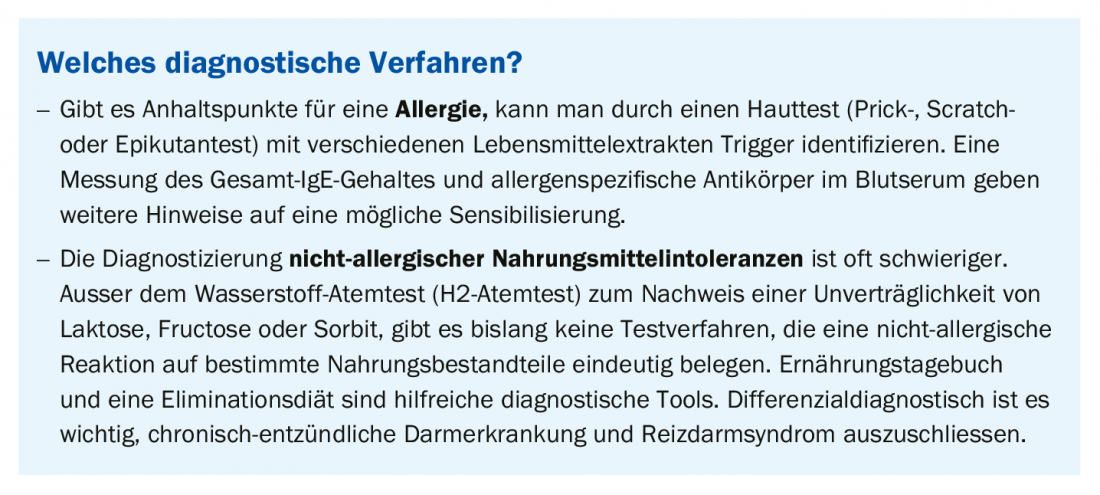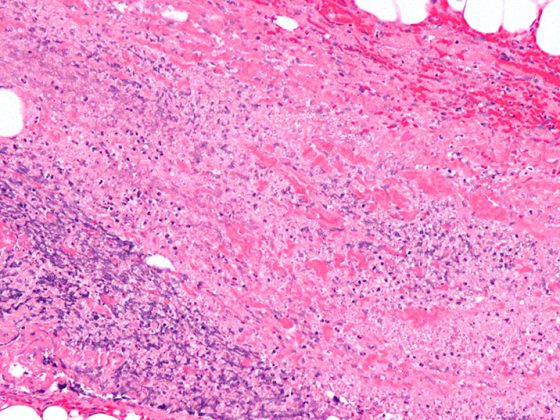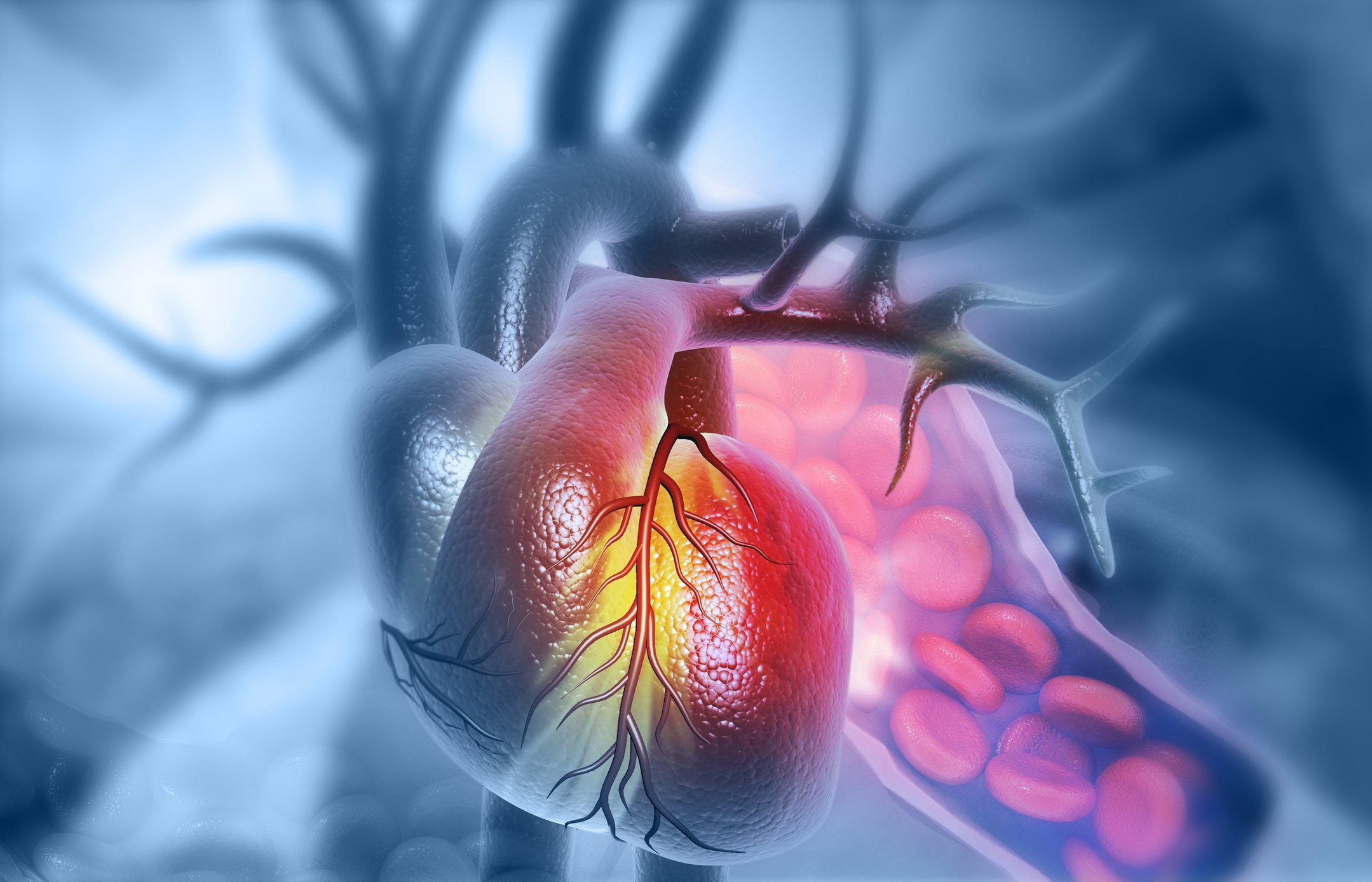Lactose intolerance is the most common food intolerance worldwide. Unlike an allergy, intolerance does not involve the immune system. If certain triggers are suspected, an elimination diet, among other things, is advisable.
True food allergies are mostly IgE-mediated reactions of the immediate type (type I allergy). Classic triggers are, for example, chicken egg protein, cow’s milk, nuts, soy or shellfish. Cross-allergies are increasingly also the cause of food intolerance. About 60% of all people with an allergy to birch pollen also react to apples because the responsible allergens are similar.
Allergy or intolerance?
More common than food allergies are intolerances that occur without the involvement of the immune system (Fig. 1). In contrast to an allergy, the IgE detection is negative in the case of a pseudoallergy. With regard to symptomatology, in the case of an allergy, reactions are usually faster and more severe. Typical signs of an allergic reaction are palate itching, tongue swelling, itching, Quincke’s edema or urticaria (hives). In extreme cases, anaphylactic shock may occur. In the case of intolerance, on the other hand, digestive complaints such as flatulence, abdominal pain, diarrhea and nausea are usually more prominent. Extraintestinal symptoms such as skin rashes, headache, or sweating may also occur, however. The most common food intolerances are lactose, fructose, gluten and histamine intolerance.

Lactose intolerance: This is the most common food intolerance in the world. The cause is reduced activity of the enzyme lactase, which breaks down milk sugar into the monosaccharides glucose and galactose. This results in complaints such as flatulence, cramps or diarrhea. Congenital complete lactase deficiency (agalactasia) is very rare. More common is an age-correlated genetically determined decline in enzyme activity . Small amounts of lactose are usually tolerated by those affected. Secondary lactase deficiency may be due to gastroenteritis, celiac disease, inflammatory bowel disease, alcohol abuse, or hyperthyroidism. If the underlying disease is treated successfully, lactose utilization usually returns to normal. The H2 breath test is recommended as diagnostic evidence of lactose intolerance; it is a method with a relatively high sensitivity and specificity. In the presence of lactose intolerance, the amount of lactose that causes digestive problems varies greatly from individual to individual [1]. The lactose content of dairy products can be found in nutrition tables. If the product has no other added sugars, the carbohydrate content is the same as the lactose content. So-called lactose-free milk products have a lactose content below 0.1 g/100 ml and are usually produced by adding lactase. There are also foods with hidden lactose in the form of added whey powder. In case of lactose intolerance, lactose-free or vegetarian milk products, for example soy milk, can be used. Those affected usually get their symptoms well under control by following a low lactose diet. If the ingestion of relevant amounts of lactose cannot be avoided (e.g. during an invitation or a visit to a restaurant), lactase preparations can reduce the symptoms. When on a low-lactose diet, ensure adequate calcium intake from other sources (e.g., calcium-rich mineral waters, hazelnuts, broccoli, spinach, kale).
Fructose intolerance: Intolerance of fructose is usually due to malabsorption, i.e. a lack of absorption via the intestinal mucosa. The transporter protein GLUT-5 in the enterocytes of the small intestine plays an important role in this process. If this is not present in sufficient quantities or only functions to a limited extent, fructose enters the colon incorrectly. There, the monosaccharide is broken down by bacteria, leading to the typical symptoms of flatulence, abdominal pain and nausea. Malabsorption can be diagnosed by an H2 breath test. In contrast, the rarely occurring hereditary fructose intolerance is the result of a congenital deficiency of the enzyme fructose-1-phosphate aldolase. This leads to a lack of breakdown of fructose and a deposit in the liver. The symptoms first appear in infancy during the transition to complementary foods and range from digestive discomfort to life-threatening symptoms of poisoning. In fructose malabsorption, on the other hand, small amounts of fructose are tolerated. Due to the dependence of the production of GLUT-5 on the amount of fructose offered, a complete renunciation is advised, otherwise there is a risk of a complete loss of absorption capacity. Frequently, persons with fructose malabsorption also do not tolerate sorbitol, since both substances are partly absorbed via the same transport proteins. However, sorbitol intolerance can also occur in isolation. An H2 breath test can also be performed for detection.

Gluten intolerance: Celiac disease is a chronic inflammatory disease of the small intestine that results from a misdirected immune response to the gluten protein and has features of both allergy and autoimmune disease [2]. IgE-mediated wheat allergy, triggered by different protein components (e.g. gluten, wheat albumin or globulin) and wheat-dependent excercise-induced anaphylaxis (WDEIA) are to be distinguished from celiac disease. Another form of gluten intolerance is the so-called non-celiac gluten allergy/wheat sensitivity (NCGS) [3]. In addition to gluten, FODMAP (fermentable oligo-, di- and monosaccharides as well as polyols) are suspected triggers [4].
Histamine intolerance: This is another possible cause of discomfort after eating certain foods. In this case, the enzyme diaminooxidase (DAO), which is required for the degradation of histamine, is not sufficiently present or only functions to a limited extent. As a result of the resulting histamine excess, the body experiences allergy-like symptoms (e.g., reddening of the skin, itching, flushing, headaches, gastrointestinal complaints). Affects about 1% of the population, predominantly middle-aged women. Foods with a high histamine content include cheese, red wine, fish and sauerkraut. Fermented foods are generally higher in histamine. Complaints may be exacerbated by certain other biogenic amines and alcohol, due to competitive inhibition of DAO. In addition, there are certain drugs that promote histamine release or decrease DAO activity (e.g., certain antihypertensives, nonsteroidal anti-inflammatory drugs, acetylsalicylic acid, x-ray contrast media, antibiotics, mucolytics). Measurement of DAO activity in blood and urine are of limited diagnostic relevance. More importantly, a dietary allowance based on the evaluation of a food diary. A low-histamine diet is indicated as a therapeutic measure, possibly supplemented by a DAO preparation.
Literature:
- Labayen I, et al: Relationship between lactose digestion, gastrointestinal transit time and symptoms in lactose malabsorbers after dairy consumption. Aliment Pharmacol Ther 2001; 15: 543-549.
- S2k guideline Celiac disease, wheat allergy, wheat sensitivity. AWMF Register No. 021/021, as of 2014, currently under revision.
- Position paper of the Working Group on Food Allergy of the German Society for Allergology and Clinical Immunology (DGAKI): Non-Celiac Gluten/Wheat Sensitivity (NCGS) – a so far undefined clinical picture with missing diagnostic criteria and unknown frequency. Allergo J Int 2018; 27: 147-151.
- Dieterich W, et al: Influence of low FODMAP and gluten-free diets on disease activity and intestinal microbiota in patients with non-celiac gluten sensitivity. Clin Nutr 2019; 38: 697-707.
- Paschke A: Food allergies. Ernährungs-Umschau 2010(1): 36-41.
Further reading:
- Wildenrath C: Allergy and intolerance. When food makes you sick. Pharmaceutical Newspaper, Sept. 08, 2019, www.pharmazeutische-zeitung.de
HAUSARZT PRAXIS 2020; 15(4): 20-21












